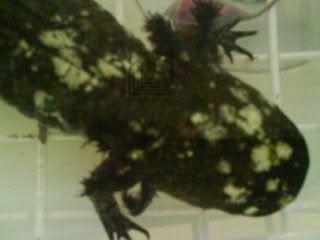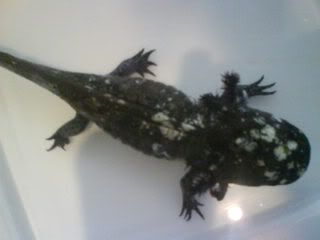Hi all!
I hope someone can help me.
I looked after my mother's Axolotl over the Christmas holidays, and I noticed some odd white spots on him. He has always had a little bit of white freckling on a dark body, but now he has lots and lots of white patches. He refused to eat the entire time that I was looking after him - which might have had something to do with the very hot summer, but is quite abnormal for him.
He looked like he had been suffering from heat stress over the hot holidays. He had some of the translucent patches of mucus on his skin (in addition to the white patches), like the pictures on http://www.axolotl.org/requirements.htm . I cooled his tank down with ice bottles, as recommended, but the patches are still there. I did 20% water changes every week, with rain water, not tap water (as it is chlorinated here). The pH of the water is just over 7.
My mother has been back for two weeks now, and he still isn't eating. The white patches on his skin are covering more of his body now. She took him to a vet here (in South Australia), and they had *no* idea what to do with an Axolotl. I got more information off the Caudata site than they were able to tell us!
I am attaching a couple of pics of him here.



I'm sorry they aren't very clear, but I hope they give you some idea. The first is in his tank, the other two are while he was in his salt bath.
It looks (to me) like he might have the Columnaris bacteria - but as I have never seen it before, I'm not sure. Can anyone tell me if it is?
Since I thought it was Columnaris, I put him in a salt bath for 10 minutes, two days in a row. On the second day, he went nuts in the salt bath, and kept trying to jump out. When I put him back in his tank, he swam around like a mad thing, and tried to jump out the sides. He is an incredibly inactive Axie, so this was a bit of a shock to me. He then spent the next half an hour or so standing on top of the filter with his head poking out of the water, gulping every 20 seconds or so. I was really worried by this behaviour, and I thought maybe it had hurt his gills somehow, so I did not repeat the salt bath.
Should I? Do Axies normally respond to salt baths like this?
Any advice you can give me would be fantastic. He hasn't eaten anything other than a couple of bloodworms since mid-December, and we're very worried about him.
Bee
I hope someone can help me.
I looked after my mother's Axolotl over the Christmas holidays, and I noticed some odd white spots on him. He has always had a little bit of white freckling on a dark body, but now he has lots and lots of white patches. He refused to eat the entire time that I was looking after him - which might have had something to do with the very hot summer, but is quite abnormal for him.
He looked like he had been suffering from heat stress over the hot holidays. He had some of the translucent patches of mucus on his skin (in addition to the white patches), like the pictures on http://www.axolotl.org/requirements.htm . I cooled his tank down with ice bottles, as recommended, but the patches are still there. I did 20% water changes every week, with rain water, not tap water (as it is chlorinated here). The pH of the water is just over 7.
My mother has been back for two weeks now, and he still isn't eating. The white patches on his skin are covering more of his body now. She took him to a vet here (in South Australia), and they had *no* idea what to do with an Axolotl. I got more information off the Caudata site than they were able to tell us!
I am attaching a couple of pics of him here.



I'm sorry they aren't very clear, but I hope they give you some idea. The first is in his tank, the other two are while he was in his salt bath.
It looks (to me) like he might have the Columnaris bacteria - but as I have never seen it before, I'm not sure. Can anyone tell me if it is?
Since I thought it was Columnaris, I put him in a salt bath for 10 minutes, two days in a row. On the second day, he went nuts in the salt bath, and kept trying to jump out. When I put him back in his tank, he swam around like a mad thing, and tried to jump out the sides. He is an incredibly inactive Axie, so this was a bit of a shock to me. He then spent the next half an hour or so standing on top of the filter with his head poking out of the water, gulping every 20 seconds or so. I was really worried by this behaviour, and I thought maybe it had hurt his gills somehow, so I did not repeat the salt bath.
Should I? Do Axies normally respond to salt baths like this?
Any advice you can give me would be fantastic. He hasn't eaten anything other than a couple of bloodworms since mid-December, and we're very worried about him.
Bee
